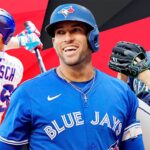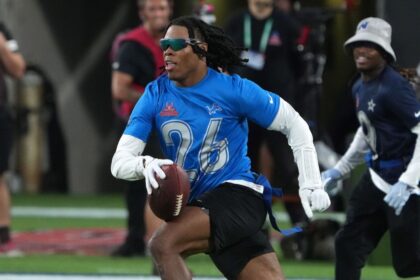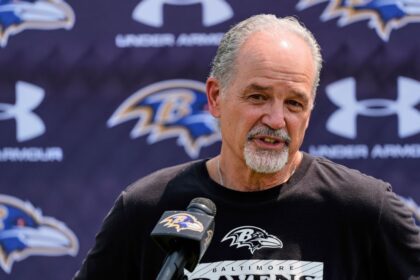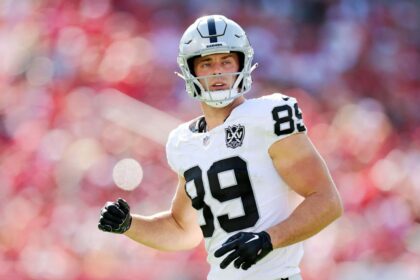- Arizona Cardinals
- Atlanta Falcons
- Baltimore Ravens
- Buffalo Bills
- Carolina Panthers
- Chicago Bears
- Cincinnati Bengals
- Cleveland Browns
- Dallas Cowboys
- Denver Broncos
- Detroit Lions
- Green Bay Packers
- Houston Texans
- Indianapolis Colts
- Jacksonville Jaguars
- Kansas City Chiefs
- Las Vegas Raiders
- Los Angeles Chargers
- Los Angeles Rams
- Miami Dolphins
- Minnesota Vikings
- New England Patriots
- New Orleans Saints
- New York Giants
- New York Jets
- Philadelphia Eagles
- Pittsburgh Steelers
- San Francisco 49ers
- Seattle Seahawks
- Tampa Bay Buccaneers
- Tennessee Titans
- Washington Commanders
Los Angeles Rams: A
Most important move: Retain QB Matthew StaffordMovement I liked: Receiving a future first-round pick in a draft-day trade with Atlanta.Move I didn’t like: Extending Tutu Atwell’s contract. The Rams’ offseason was excellent because it included moves that will help the team win now and in the future. The offseason began with rumors that Stafford could leave, and the Rams gave him permission to speak with other teams to assess his value. Although Stafford had conversations with the Giants and Raiders, he ultimately renewed his contract with Los Angeles with a restructured deal that guarantees him $40 million in 2025 and $40 million non-guaranteed in 2026. That’s good value for the team, considering Stafford’s ability. This seemed well played by the Rams, who, to some extent, discovered Stafford’s bluff. Stafford got more money from them than expected, but they were able to keep a top-tier quarterback at an affordable price. The team also made two other high-priced moves to support their QB. In particular, the Rams signed wide receiver Davante Adams to a two-year contract averaging $22 million per season (and including $26 million fully guaranteed). At 32 years old, Adams is not the player he used to be, although he managed 2.1 yards per route run last season and his open score in ESPN’s receiving metrics was a 77, more than respectable. There are no guarantees, but I like this move, especially along with the team’s decision to release Cooper Kupp. He’s also 32, but he’s three years removed from his last 1,000-yard season. The Rams did well to move on. L.A. also re-signed left tackle Alaric Jackson to a three-year contract that averages less than $18.8 million per year with $35.4 million fully guaranteed, according to Roster Management System. Jackson has developed into a positive starting tackle and was above average last season in pass-blocking win rate and run-blocking win rate. The Rams also achieved great results in the transfer market. In particular, they traded with Atlanta on draft night in a deal that gave Los Angeles picks 46 and 242 and a 2026 first-round pick for picks 26 and 101. This was a great achievement, as the Rams came out in great shape in terms of average value, but with potential for much more. If the Falcons fail this season, which is within the range of possible outcomes, the Rams will have obtained a very high pick. And with Stafford turning 37, that pick could help bring in his successor. They also pulled off a move by trading guard Jonah Jackson to the Bears. The Rams were obligated to pay $8.5 million in guaranteed money out of a total of $17.5 million owed to Jackson, whom the Rams tried to move to center before he suffered an injury and was then relegated to the bench. At that price, Jackson was a possible candidate to be cut, and if he was going to be traded, I assumed the Rams would have to take on a portion of the contract. I was wrong. The Bears came and gave the Rams a sixth-round pick to take Jackson and his entire contract off their hands. However, not everything was perfect. The Rams signed Atwell to a one-year, $10 million contract that made me wonder: Who was clamoring to pay him $9 million?San Francisco 49ers: A-
Most important move: Extend QB Brock Purdy’s contractMovement I liked: Hiring Robert Saleh as defensive coordinatorMovement I didn’t like: None After a disappointing 6-11 campaign, the 49ers opened their offseason by bringing back Saleh, their defensive coordinator from 2017 to 2020. Although his time as head coach with the Jets was unstable, his defenses ranked among the top five in expected points added per play in 2022, 2023, and the first five weeks of 2024, before being fired. After the firing, the Jets’ defense plummeted to 30th in EPA per play. But San Francisco’s most important move came when the long-awaited Purdy extension finally happened, as the 49ers gave their quarterback a deal worth $53 million per year, with $100 million fully guaranteed. There are mixed opinions on the exact level of Purdy’s responsibility for the 49ers’ passing success, but he fits perfectly with what they want to do. San Francisco reached elite levels of passing efficiency with Purdy in 2023, performing at a higher level than it achieved with Jimmy Garoppolo. The deal was also cheaper than expected. If it had been $60 million per year, it would have been in line with the 2024 deals of Trevor Lawrence and Jordan Love when adjusting for salary cap inflation, and I wouldn’t have blinked.Before free agency, the 49ers traded Deebo Samuel Sr. to the Commanders in exchange for a fifth-round pick. It was a year too late, although that’s easy to say with the benefit of hindsight. Samuel’s production has declined: he recorded only 670 receiving yards and 1.8 yards per route run in 2024. He has always performed poorly in ESPN’s receiver tracking metrics, which didn’t matter in his prime because he essentially broke the yards-after-catch scale.
Arizona Cardinals: A-
Most important move: Sign Josh Sweat.Movement I liked: Extending Trey McBride’s contract.Move I didn’t like: Not re-signing Will Hernandez The Cardinals entered the offseason with the intention of improving their defense. Ultimately, the team only brought in one notable free agent, Sweat, but did so in a position of serious need. Sweat, who got a four-year contract averaging $19.1 million, was coming off an incredible Super Bowl in which he recorded 2.5 sacks and was a contender for the game’s MVP. Somehow, I was surprised he didn’t get more money, but there are reasons to be skeptical. In 2024, Sweat’s get-off (time to cross the line of scrimmage) decreased from 0.73 seconds to 0.85. And his pass-rush win rate also fell substantially, from 20% in 2023 (above average) to 11% (below average). Before 2024, Sweat had had three consecutive seasons with pass-rush win rates of more than 20%, reaching a high of 26% in 2021. Although he had a strong finish, I would have been more optimistic about Sweat a year ago. He has also only had one season with double-digit sacks. But Sweat was the best edge free agent and has shown his ability to win day in and day out in previous seasons. So, I’m good with the four-year contract that averages $19.1 million, especially considering how much Arizona needed a pass rusher. Arizona also signed McBride to an extension, which also averages $19 million per year, which I am in favor of. McBride had a very efficient 2.32 yards per route run (and a total of 1,146 receiving yards) in 2024, acting as one of the best tight ends in the league. The money puts him near the top of the tight end market, but it’s slightly cheaper per year, after adjusting for salary cap inflation, than what the Patriots gave Jonnu Smith and Hunter Henry in 2021. I also liked some of Arizona’s smaller deals. At $6.25 million per year for two years, Jacoby Brissett’s contract is a bargain, and I wonder why teams with more unstable quarterback situations didn’t top that. Also, bringing back Calais Campbell on a one-year, $5.5 million deal isn’t just a feel-good story. Campbell led all players in run stop win rate in 2024, along with a 12% pass rush win rate that ranked ninth among defensive tackles. An objection could be that the Cardinals didn’t bring back Hernandez or that they didn’t find a cheaper guard. Hernandez tore his left ACL early last season, but he had a very solid pass-blocking win rate of 94.6% or higher before the injury and in each of the two previous seasons.Denver Broncos: A-
Most important move: Re-signing D.J. JonesMovement I liked: Re-hiring JonesMovement I didn’t like: Not adding more receivers The Broncos finished last season as the league’s best defense by EPA per play and decided to improve even more. They signed linebacker Dre Greenlaw and safety Talanoa Hufanga, re-signed Jones, and used their first-round pick on cornerback Jahdae Barron. This defense could be outrageous, and I like that Denver has taken this route.We often talk about teams betting all their chips when their quarterback is on a rookie contract, but there’s no requirement to use those chips on offense. Bo Nix was okay (maybe a little overrated) in his first season, ranking 18th in QBR, and much of that value came from his legs (he ranked 27th in yards per pass attempt and 28% in completion percentage above expectation). He could show growth in the second year, but a team with a quarterback like Nix needs a stacked roster. Denver has it.
The move I liked the most was bringing Jones back at $13 million per year in an offseason where defensive tackles were very well paid. Jones ranked second in run stop win rate as an interior defender last season and sixth in run stop push, the distance pushed on run plays, as a nose tackle, which helped shut down the run and forced opponents to test a secondary that features Defensive Player of the Year Pat Surtain II.I can agree with the Hufanga and Greenlaw moves, in part because both players represent high risk (of injury) and high reward. If the Broncos are going to compete in 2025, they will need some bets to pay off, so it makes sense to take some. Greenlaw’s contract is particularly attractive because only $11.5 million is fully guaranteed.
The big offensive addition was tight end Evan Engram, giving Sean Payton and Nix another receiving threat who creates plays. Engram, who will turn 31 before the season, is not a sure bet considering his age and the hamstring and labrum injuries that limited him to nine games in 2024. Denver didn’t get Engram cheap ($11.5 million per year and $16.5 million fully guaranteed), but he represents a big improvement. I wanted to see the Broncos do more at receiver. Besides having Courtland Sutton and Engram, they’re probably hoping Marvin Mims Jr. or Troy Franklin will break out. Maybe they’ll end up making a move for another veteran, perhaps Keenan Allen or Amari Cooper?Baltimore Ravens: B+
Most important move: Re-signing Ronnie StanleyMovement I liked: Signing Chidobe AwuzieMove I didn’t like: Selecting Mike Green in the second round The most important and significant move by Baltimore, re-signing Stanley to a three-year, $60 million contract, came before the start of the 2025 league year. It was not a risk-free choice. Although he played all 17 games in 2024, Stanley, 31, has missed 36 games in the last five seasons due to ankle, shoulder, and knee injuries.But re-signing Stanley was critical due to the lack of alternatives. The next available free agent tackle was probably Dan Moore Jr., who offers slightly less certainty than Stanley (and I’m a Moore fan!). Moore signed with the Titans basically on the same terms as Stanley. The Chiefs had to resort to a combination of Jaylon Moore and first-round pick Josh Simmons to fill their tackle gap.
Given the Ravens’ status as a major Super Bowl contender, left tackle was not a place to take risks. And they didn’t have to pay a premium! Stanley’s $20 million per year ($44 million fully guaranteed) is far from the top of the tackle market. In the last five years, Trent Williams, David Bakhtiari, Laremy Tunsil, Tristan Wirfs, and Penei Sewell signed deals that averaged over $30 million per year in 2025 money when adjusted for salary cap inflation, according to OverTheCap.com. Beyond Stanley, the Ravens made their typically useful moves to augment the roster on the margins. Veterans DeAndre Hopkins, Jaire Alexander and Ch








